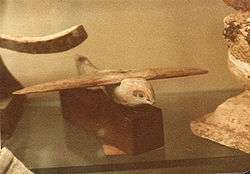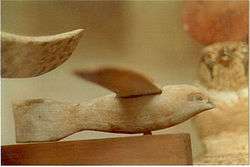Saqqara Bird
The Saqqara Bird is a bird-shaped artifact made of sycamore wood, discovered during the 1898 excavation of the Pa-di-Imen tomb in Saqqara, Egypt. It has been dated to approximately 200 BCE, and is now housed in the Museum of Egyptian Antiquities in Cairo. The Saqqara Bird has a wingspan of 180 mm (7.1 in) and weighs 39.12 g (1.380 oz).[1] Its purpose is not understood because of a lack of period documentation.


Conventional ideas
Some think the Saqqara Bird may be a ceremonial object because the falcon, the bird after which the Saqqara Bird is modeled, is the form most commonly used to represent several of the most important gods of Egyptian mythology, most notably the falcon deity Horus and the sun deity Ra Horakhty. Others have posited it may have been a toy for an elite child, or that it could have functioned as a weather vane. Some have also speculated it may have been used as a sort of boomerang, as such technology was common and well known in ancient Egypt in the form of a throwing stick used for hunting waterfowl.[2] Another hypothesis is that this bird was positioned on the masthead of sacred boats used during the Opet Festival.[3] Reliefs showing those boats are found in the Temple of Khonsu at Karnak and date to the late New Kingdom.[4]
Controversial ideas
Some have suggested that the Saqqara Bird may represent evidence that knowledge of the principles of aviation existed many centuries before such are generally believed to have first been discovered. Egyptian physician, archaeologist and parapsychologist Khalil Messiha has speculated that the ancient Egyptians developed the first aircraft.[5] In spite of these claims, however, no ancient Egyptian aircraft have ever been found, nor has any other evidence suggesting their existence come to light. As a result, the theory that the Saqqara Bird is a model of a flying machine is not accepted by mainstream Egyptologists. Richard P. Hallion notes that it is "far too heavy and unstable itself to fly."[6]
See also
References
- Messiha, Hishmat (1973). "[Saqqara Bird]". Egypt Travel Magazine. Cairo: Ministry of Tourism, Dept. of Publicity (153). ISSN 0013-2381. OCLC 1567664.
- Larry Orcutt (2001). "Model Airplane?". Catchpenny Mysteries of Ancient Egypt. Retrieved 2010-04-18.
- Khonsu Temple relief with three sacred boats
- The Temple of Khonsu, Volume 1: Scenes of King Herihor in the Court, The Epigraphic Survey. Chicago: The Oriental Institute, 1979. ISBN 0-918986-20-6. Reproduction of the reliefs are visible at page 107 and following pages ".
- Messiha, Khalil; et al. (1991). "Aeronautics: African Experimental Aeronautics: A 2000-Year Old Model Glider". In Ivan van Sertima (ed.). Blacks in Science: Ancient and Modern. Journal of African Civilizations. vol. 5, no. 1-2. New Brunswick: Transaction Books. pp. 92–99. ISBN 0-87855-941-8. Retrieved 2010-04-21.
- Hallion, Richard P. (2003). Taking Flight: Inventing the Aerial Age, from Antiquity Through the First World War. New York: Oxford University Press. p. 11. ISBN 978-0195160352.
sakkara.